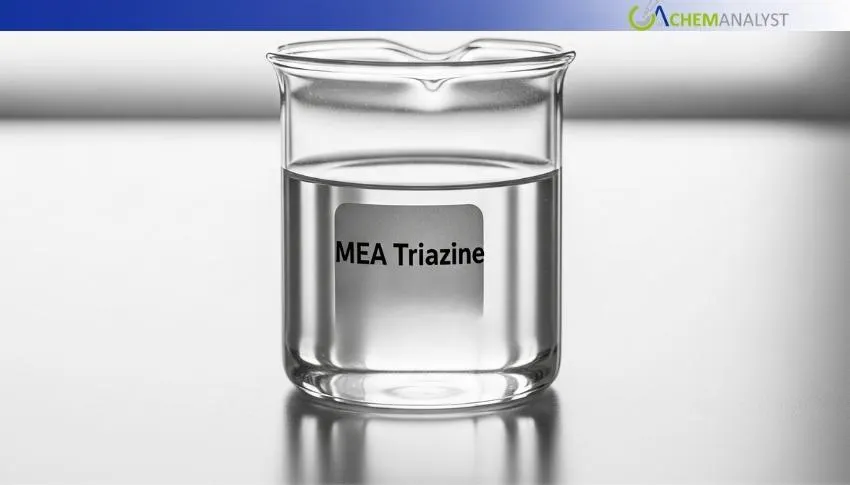Welcome To ChemAnalyst

Global MEA Triazine prices fell in July 2025, down in North America and Asia, driven by ample supply, weak demand, and cheaper feedstock MEA. Oversupply pressured markets despite steady refinery runs, though late-August recovery signs emerged.
Global MEA Triazine prices were reported to have fallen in July 2025, depreciating by around 7% in North America and approximately 5% in Asia. The downturn in the prices of MEA Triazine was largely driven by ample supply conditions and subdued demand from the downstream oil and gas refining sectors across the Asian and North American markets, which showed little improvement between June and July. Primary Middle Eastern MEA Triazine exporters based in Saudi Arabia were reported to have been aiming to maintain lean inventory levels, resulting in steady inflows of competitively priced cargoes into consuming regions. Further bearish momentum across the global MEA Triazine was reinforced by a 13% fall in feedstock Monoethanolamine (MEA) prices in Saudi Arabia, which reduced production costs and led to lower landed prices across both North America and Asia. Supply was reported to be abundant, with sellers in the U.S., China, and other Asian markets working through backlogged inventories from previous months, leaving the market largely oversupplied.
Across the US market, demand for MEA Triazine remained cautious through July and into early August 2025. Uncertainty surrounding tariff measures and the lack of clarity regarding their scope injected volatility into the broader economy, prompting companies and consumers to delay purchases. Many buyers relied on drawing down existing inventories rather than committing new orders which resulted in limited support of prices from the demand side. Consumption levels of MEA Triazine were steady but moderate, as reflected in gasoline and refinery data. Average motor gasoline output stood at 229,970 bpd in June and 230,467 bpd in July, showing only a marginal month-on-month increase. Refinery utilization rates also followed a similar trend, averaging 94.28% in June and rising slightly to 94.88% in July, according to weekly EIA data. These incremental gains in production and operating rates did little to tighten supply-demand balances, leaving surplus inventories of MEA Triazine in the market and sustaining a bearish undertone.
Across Asia, and particularly in China, tariff volatility and ongoing weakness in the petrochemical sector weighed heavily on demand. Some support was derived from stronger refined product exports, with gasoil shipments rising sharply. Chinese oil companies were expected to export around 640,000 MT of gasoil in July, up 88% from 340,000 MT in June, driven by improved export margins after crude prices strengthened amid geopolitical tensions in the Middle East. However, broader MEA Triazine demand conditions remained subdued. Crude oil imports into China fell by 5.4% month-on-month in July after reaching a near two-year high in June at 47.2 million tons, equivalent to 11.11 million bpd. Despite lower imports, refinery utilization rose to 71.84% in July, up 1.02 percentage points from June and 3.56 points compared to a year earlier. Market insights suggested that state-owned refiners raised throughput while independent refiners reduced runs under margin pressure and scheduled maintenance, which collectively reduced refining output by about 7.9 million tons during the month thus weakening consumption. Although three refineries with a combined capacity of 28.7 million tons resumed operations post-maintenance, this offered only limited support to MEA Triazine consumption, leaving overall demand conditions weak.
Expectations for higher MEA Triazine prices prevailed toward the end of August 2025, supported by signs of a gradual rebound in demand, particularly from the U.S. market, where weekly refinery run rates stabilized above 96% during the month. Demand conditions for MEA Triazine in Asia also showed improvement, with total oil product shipments, including gasoline, diesel, aviation fuel, and marine fuel—rising to 5.34 million tons in July, up 7.1% year-on-year, reinforcing the outlook for a potential price recovery. Further support came from supply-side adjustments, as Middle Eastern suppliers, particularly those based in Saudi Arabia, were reported to have largely depleted excess inventories by offloading stocks in July. At the same time, feedstock Monoethanolamine (MEA) prices recovered by 3.3% in early August, adding to cost-side support. These developments collectively bolstered market sentiment and strengthened expectations of an upward movement in MEA Triazine prices heading into late August 2025.
We use cookies to deliver the best possible experience on our website. To learn more, visit our Privacy Policy. By continuing to use this site or by closing this box, you consent to our use of cookies. More info.
